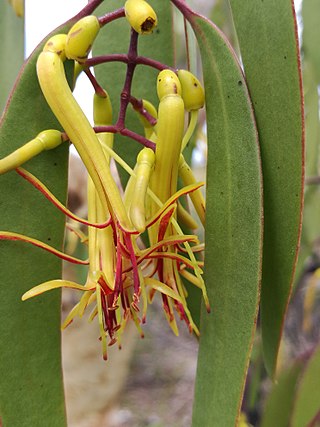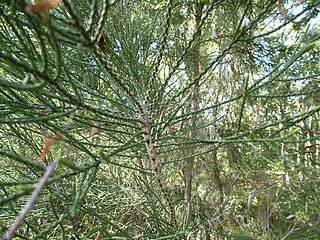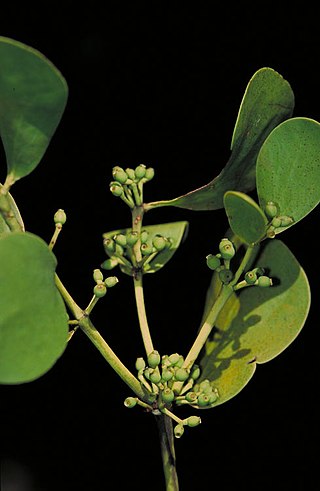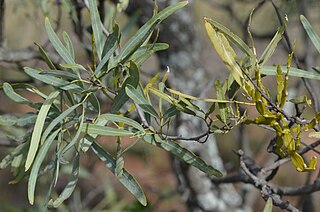
Amyema quandang is a species of hemi-parasitic shrub which is widespread throughout the mainland of Australia, especially arid inland regions, sometimes referred to as the grey mistletoe.

Dendrophthoe vitellina, commonly known as long-flowered- or apostle mistletoe, is a hemiparasitic plant of the mistletoe family Loranthaceae. The genus Dendrophthoe comprises about 31 species spread across tropical Africa, Asia, and Australia. Despite being collected by Joseph Banks and Daniel Solander in 1788, and depicted in Banks' Florilegium, it was not until 1860 that it was described by Ferdinand von Mueller as Loranthus vitellinus after being collected near Ipswich, and renamed by Philippe Édouard Léon Van Tieghem in 1895.

Acacia argyrodendron, known colloquially as black gidyea or blackwood, is a species of Acacia native to Australia. Czech botanist Karel Domin described this species in 1926 and it still bears its original name. Domin reported collecting the type specimen from somewhere between Camooweal and Burketown in northwestern Queensland, though it is more likely to have been northeast of Aramac.

Dendrophthoe glabrescens, commonly known as smooth mistletoe or orange mistletoe, is a hemiparasitic plant of the mistletoe family Loranthaceae, found in eastern and northern Australia. It flowers from October to January. The flowers are tubular, with a green base, but where the tube splits open, it displays orange and bright red.

Amyema benthamii, commonly known as the twin-leaved mistletoe or Bentham's mistletoe, is a species of flowering plant, an epiphytic hemiparasitic plant of the family Loranthaceae native to Western Australia and the Northern Territory of Australia in semi-arid woodland. This species is named in honour of the English botanist George Bentham who between 1863 and 1878 published Flora Australiensis, the first flora of Australia.

Lysiana exocarpi, commonly known as harlequin mistletoe, is a species of hemiparasitic shrub, endemic to Australia. It is in the Gondwanan family Loranthaceae and is probably the most derived genus of that family with 12 pairs of chromosomes. The Loranthaceae is the most diverse family in the mistletoe group with over 900 species worldwide and including the best known species in Australia. Mistletoes are notable for their relationships with other species. In an early reference to the group in Australia Allan Cunningham explorer and first Director of the Royal Botanic Gardens, Sydney, wrote in 1817: "The Bastard Box is frequently much encumbered with the twining adhering Loranthus aurantiacus which 'Scorning the soil, aloft she springs, Shakes her red plumes and claps her golden wings'."

Muellerina is a genus of parasitic aerial shrubs in the family Loranthaceae.

Melaleuca foliolosa is a plant in the myrtle family, Myrtaceae and is endemic to northern Queensland in Australia. It is distinguished by it very small leaves which are pressed against the stem and almost overlap each other.

Muellerina eucalyptoides, commonly known as creeping mistletoe, is a hemiparasitic aerial shrub in the family Loranthaceae. The species is endemic to Australia.

Amyema bifurcata is an epiphytic, flowering, hemiparasitic plant of the family Loranthaceae native to Australia and found in Western Australia, the Northern Territory, Queensland and New South Wales.

Amyema sanguinea is an aerial hemiparasitic shrub within the genus Amyema, in the family Loranthaceae and native to Australia, where it is found in New South Wales, Queensland, the Northern Territory, South Australia and Western Australia.

Amyema melaleucae, also known as the tea-tree mistletoe, is a species of flowering plant within the genus Amyema, an epiphytic hemiparasitic plant of the family Loranthaceae native to Australia and found in Western Australia and South Australia on the coast, from north of Perth almost to the Victorian border.

Muellerina myrtifolia, common name myrtle-leaved mistletoe, is a hemiparasitic aerial shrub in the family Loranthaceae. The species is endemic to New South Wales and Queensland.

Muellerina flexialabastra, common name Hoop pine mistletoe, is a hemiparasitic aerial shrub in the family Loranthaceae. The species is endemic to Queensland.

Muellerina celastroides, common names Banksia mistletoe and coast mistletoe, is a hemiparasitic aerial shrub in the family Loranthaceae. The species is endemic to New South Wales, Victoria and Queensland.

Cecarria is a monotypic genus in the family Loranthaceae. The sole species is Cecarria obtusifolia, a hemiparasitic aerial shrub.

Amylotheca is a genus of hemi-parasitic aerial shrubs in the family Loranthaceae, found in Borneo, Malaysia, New Caledonia, New Guinea, Australia, Sumatra, Thailand, Vanuatu, and Philippines

Korthalsella rubra is a flowering plant in the Santalaceae (sandalwood) family, formerly placed in the Viscaceae.
Amyema plicatula is a species of hemi-parasitic shrub found in the Bismarck Archipelago, New Guinea, New South Wales and Queensland.

Amyema miraculosa, also known as the fleshy mistletoe and the round-leaf mistletoe, is an Australian native mistletoe found in all states except Tasmania. It is a woody, hemiparasitic plant, in the Loranthaceae family. Being hemiparasitic, it draws water and minerals from its host, however it photosynthesises to manufacture its own supply of carbohydrates.






















